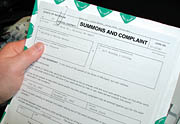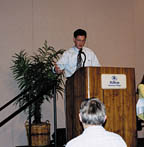
At the 2002 Annual Meeting of the American Society of Heating, Refrigerating, and Air-Conditioning Engineers (ASHRAE), of course, the target audience was engineers; but the message from the seminar “How to Avoid Being Sued for Negligence: What Every ASHRAE Member Should Know About the Standard of Care in Systems Design, Comfort, and IAQ,” carries over to all HVAC professionals, including contractors.
The question of the standard of care was pivotal, if you recall, in the South Carolina Association of Heating and Air Conditioning Contractors’ (SCAHACC’s) “Mock Mold Trial,” reported here in The News in March and voted on at The News’ website (www.achrnews.com). The standard of care, presented strongly enough, could turn a contractor’s “not guilty” verdict into “guilty.”
WHAT IS THE STANDARD OF CARE?
Attorney William G. Frey, Esq. (Wolf, Block, Schorr and Solis-Cohen LLP, Philadelphia, PA), defined negligence as the failure to exercise “ordinary skill and knowledge.” Negligence could be a dangerous act or omission. It is a departure from a reasonable standard of care.That standard of care can be described as a “reasonable person standard,” Frey explained. “Each person is required to do what a reasonable, fictitious person would do.”
IAQ is a huge area of litigation within the building industry, particularly those involved with HVAC, and most particularly those working in hot, humid climates. There is currently an insurance crisis, he said. The crisis is largely due to three things: Sept. 11, Enron, and toxic mold claims in Texas.
It’s that big.
Insurance companies, he continued, will do whatever they need to in order to recoup costs and/or avoid payouts. “If momma ain’t happy, ain’t nobody happy,” Frey said. “The insurance industry isn’t happy.” Insurers will try to recover their costs through members of the construction industry.
If you are being sued for damages resulting from illness related to an HVAC system you designed and/or installed, know that the plaintiff must prove:
Did you follow a reasonable standard of care for your trade? According to Frey, here’s the formal definition:
“Unless he/she represents that he/she has greater skill or knowledge, one who undertakes or renders services in the practice of a profession or trade is required to exercise the skill and knowledge normally possessed by members of that profession or trade in good standing, in similar communities.”
Pay attention to that part about “similar communities,” Frey said. “If you are a mechanical engineer practicing in Florida, Louisiana, or Texas, you had better know about moisture and IAQ.” If there are known problems in your area, the knowledge to deal with it will be expected of you as a professional in that community.
Neglect can be proven by showing violation of a building code, which is negligence per se, Frey said. He added that “15 recent cases cited ASHRAE standards in evidence as standard of care.” Some also cited the most recent ASHRAE Handbook.

DESIGN AND COMFORT
Raymond Patenaud, CIAQP, P.E. (The Holmes Agency Inc., St. Petersburg, FL), discussed “Standards of Care in System Design.”He asked the audience, for starters, if they are still relying on the 1993 edition of ASHRAE Fundamentals. If so, “Throw that out,” he said. “The newer version has better information for part-load design in hot humid climates.”
Patenaud described some of the most common types of moisture problems:
At the most basic level, in humid climates, “Consider outdoor air as food” that aids biological growth. Use appropriate filtration and size the cooling coil for the latent load. “It’s very hard to attack someone [in court] who has done something to address moisture,” Patenaud said.
Knowledge is the best protection for HVAC professionals. Patenaud recommended the following reading to bring yourself up to date:
Ignorance is not a good legal tactic for professionals, Patenaud pointed out. “It’s very difficult to say in court, ‘I just didn’t know that.’”
Daniel Int-Hout III (Krueger, Richardson, TX) covered “The Standard of Care in Comfort.” Comfort, he said, includes air distribution, thermal comfort, acoustics, and IAQ. “All four must work together.”
However, too many people are making decisions in one area that affect the other three. These systems must be looked at holistically.
Thermal comfort, he pointed out, is now the No. 1 reason for not renewing the lease, according to the Building Owners and Managers Association (BOMA) International. It used to be the elevators. “Way to go,” he said; “we took the No. 1 spot.”
DON’T GET BLINDSIDED
James Woods, Ph.D., P.E. (HP-Woods Research Institute, Herndon, VA), stated that “The IAQ standard of care is not well defined. Diligence is required to read updated materials.”While discussing “The Standard of Care in Indoor Air Quality,” he said that current drivers for building owners and the market are global warming, green buildings, sustainability, extraordinary incidences, productivity, and fear of terrorism.
“We need to deal with both the threat and fear of terrorism,” he said.
In all cases, the HVAC professional’s main IAQ goals are:
Indoor air goes from its original state, a supposedly acceptable state, through continuous degradation as the system ages, Woods said. The goal is for an “interception of degradation,” through “continuous diagnostics; intervention, and a return to a healthy state.”
Most cases that reach litigation, Woods said, fall into one of two categories:
1. There was premature occupancy initially or after renovation.
2. There was occupation during renovation.
“Design for wellness rather than illness,” Woods said. “Evaluate the building after turning it over.”
Publication date: 07/22/2002

Report Abusive Comment